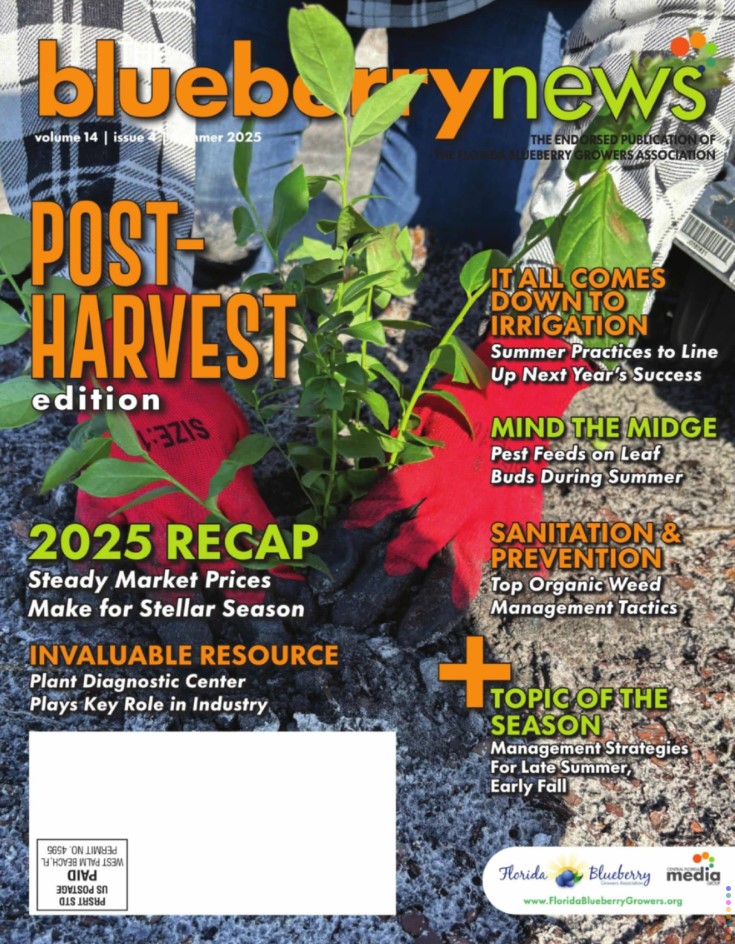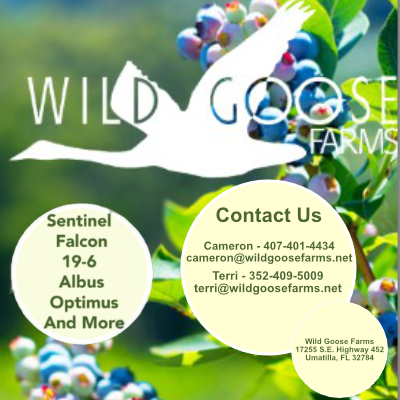Recommendations for Rust Management in the Evergreen System
The evergreen production system for southern highbush blueberry (SHB) is used extensively in the south-central and central regions of Florida. Under this system, blueberry plants do not go dormant and are harvested early in the season. One of the primary management requirements in the evergreen system is to keep the foliage healthy and intact through the harvest season. A significant challenge to accomplishing this is fungal leaf disease, especially rust. This article will provide some background and information on this disease, as well as a suggested fungicide program to minimize the incidence and severity of rust.
In Florida, rust on SHB is reported to be caused by the fungus Naohidemyces vaccinii. Plants with rust can show premature defoliation, decreased floral bud differentiation, and reduced yield. Different levels of susceptibility to this disease can be found in SHB; for example, certain cultivars, such as “Jewel,” are known to be highly susceptible. A new collaborative project to characterize blueberry rust in Florida and sources of resistance within the UF Blueberry Breeding Program was started this fall and aims to improve understanding and growers’ options for resistant varieties.
Symptoms are initially observed as small, somewhat angular yellow spots, turning red to black, on the upper surfaces of leaves. This is usually limited by larger leaf veins, resulting in lesions with parallel straight or angular sides. Multiple lesions can occur on the same leaf, turning the leaves yellow and red over time (Figure 1) before causing defoliation. Yellow to orange rust colored spores appear on the underside of the leaf, opposite the lesions on the upper leaf surface, giving this disease its name. The presence of these spores is key to distinguishing this disease from other leaf spot diseases (Figure 2).
Figure 1. Rust symptoms on upper side of leaf
Credits: P. Harmon, UF/IFAS
Figure 2. 17
Credits: P. Harmon, UF/IFAS
In evergreen production in central and south-central Florida, the rust pathogen can survive on infected leaves that remain on the plants throughout winter, and its spores are spread by wind. Spores can also survive over the winter on other evergreen plants of Vaccinium species in the areas surrounding production fields. New leaf infections can begin in spring during or just after harvest, and disease activity increases again in early fall.
The best method of control is the application of fungicides. Systemic fungicides move into infected leaves and potentially stop rust development. However, most products will only reduce or delay the amount of sporulation because fungicides do not effectively kill the fungus inside the leaf. Fungicides do a better job protecting against new infections, so making repeated applications to maintain a protective residue on the leaves is key to preventing the disease.
Although the same products are used, the timing and application strategy should differ between evergreen and deciduous production. Two reasons for this include the timing of disease occurrence and the differential importance of late-season foliage management between the two production systems. Rust, like all diseases, varies from year to year in the severity and exact timing of when outbreaks start and how bad they get. Typically, in deciduous production areas, rust comes in around or just after harvest, slows in the heat of summer, and picks back up during rainy periods of fall. Deciduous growers have been encouraged to continue management inputs until late fall (about October) when the disease progress slows with drier weather. At that point, the disease contributes to defoliation without demonstrated yield impact the following year. The pathogen does not survive on dead leaves or stems like some other fungi can, so the amount of spores available when new leaves are pushed in spring has been drastically reduced.
In the southern evergreen-producing regions of the state, rust tends to be slow in summer, becoming problematic around the end of September or thereabouts. Disease pressure persists all the way through harvest and the summer hedge. There are other foliar disease concerns during summer that can require fungicide inputs like anthracnose and target spot, but in evergreen production, these applications don’t usually give the overlapping rust protection afforded to the deciduous system. That means a longer period of time when leaves need protecting, and often that translates to more fungicide inputs required. The same protection vs cure principle applies here in that once the disease becomes severe, options become fewer, less effective, and more costly. Severe rust in evergreen production can even infect and blemish fruit if left unchecked.
Options to consider: Chlorothalonil (sold as Bravo and others) applications starting late fall, before bloom. Chlorothalonil is a contact fungicide that we cannot use after bloom and that some growers have concerns about causing leaf burn in the heat of summer. When not used during summer, these apps made when disease pressure is generally low and starting to increase make good sense. As the season progresses, scout for rust disease. Scouting means walking rows, turning over leaves with spots and looking for the orange spore masses. As rust starts to pick up on the interior lower canopy leaves, consider using Proline (prothioconazole). It has stood out in some published research as an excellent choice among DMI products for rust. Other DMI’s with longer PHI’s can also be considered if rust picks up much before bloom (examples: Indar, Tilt). They will have some efficacy, and this will leave the Proline option (7-day PHI) for flare-ups closer to harvest. Abound and Pristine both also have rust efficacy and make for good rotations with one of the DMI’s. If applied at or after bloom, consider tank mixing a captan product with Abound or Pristine, because of the widespread anthracnose ripe rot resistance to these products. One or more of these options employed in the late fall to pre bloom period should do a good job of keeping rust severity low through harvest. These preventive measures will yield better results than those employed once defoliation and fruit infections are common in the field.
CREDITS:
Dr. Phil Harmon, Professor, UF/IFAS
& Doug Phillips, Blueberry Extension Coordinator, UF/IFAS





